Accurate, Low-Level Sulfur Analysis by ICP-MS Using MS/MS with Oxygen Reaction Cell Gas
Combined with appropriate selection of instrument components to reduce the sulfur background, ICP-MS using MS/MS with oxygen reaction cell gas can provide accurate low-level analysis of sulfur and sulfur isotope ratios in aqueous and organic matrices. This is useful in applications in life science, clinical research, pharmaceutical development, food safety, environmental monitoring, geochemistry, and petrochemistry.
Sulfur (S) is one of a small group of elements that have historically been difficult to analyze at low levels using conventional inductively coupled plasma–mass spectrometry (ICP-MS). Accurate low-level analysis of sulfur is required in applications in life science, clinical research, pharmaceutical development, food safety, environmental monitoring, geochemistry, and petrochemistry. ICP-MS analysis of sulfur is problematic because of the element’s high first ionization potential, which reduces sensitivity. Also, intense polyatomic interferences affect all the isotopes of sulfur. Background levels are also often high, due to the presence of S in many components used in laboratory equipment. ICP-MS fitted with a collision/reaction cell can use oxygen (O2) cell gas to mass shift the 32S+ ions to SO+ product ions at mass-to-charge (m/z) 48, avoiding the on-mass interferences at m/z 32. However, mass 48 can also be affected by interference from 48Ca+, 48Ti+, and 36Ar12C+, as well as from overlapping product ions such as 31P17O+. Also, applications such as isotope ratio measurements and isotope dilution mass spectrometry (IDMS) require the accurate determination of a minor isotope, 34S or 33S, as well as 32S. We describe how tandem mass spectrometry (MS/MS) controls the O2 reaction gas chemistry to resolve multiple spectral overlaps on all the sulfur isotopes. Combined with appropriate selection of instrument components to reduce the sulfur background, MS/MS can provide accurate low-level analysis of sulfur and sulfur isotope ratios in aqueous and organic matrices.
Inductively coupled plasma–mass spectrometry (ICP-MS) is widely used for multielement analysis of trace analytes in a wide variety of sample types. A few elements, including sulfur (S), are difficult to measure using conventional (single)
quadrupole ICP-MS.
Applications that require low level sulfur analysis include petrochemical analysis (1,2), the study of biomolecules (such as proteins) in life science research (3,4), detection of sulfur compounds in foods (5), and development of sulfur-based pharmaceuticals (6,7). Accurate determination of sulfur at low concentrations is affected by several factors:
1.Sulfur has a high first ionization energy (or ionization potential) of 10.36 electron volts (eV), meaning it is only around 10% ionized in a normal ICP plasma. This translates into 10x lower sensitivity than for a fully ionized element.
2.The main isotope of sulfur (32S, 95.04% abundance) suffers intense background overlap from polyatomic ions including 16O2+ and 14N18O+, making trace analysis impossible by conventional quadrupole ICP-MS.
3.The next most abundant isotope, 34S, accounts for only 4.2% of total sulfur, meaning a further reduction in sensitivity by a factor of more than 20. This isotope also suffers from intense background interferences, as does the final potentially useful isotope, 33S (0.75% abundance). The fourth naturally occurring isotope, 36S, is only 0.015% abundant, and is overlapped by a minor isotope of argon. The most significant background polyatomic ions that overlap the isotopes of sulfur are shown in Table I.

4.Sulfur is present in many laboratory reagents and components, causing background contamination.
The commercial development of collision–reaction cells (CRCs) for ICP-MS in 1997 (8) provided analysts with a novel approach to controlling interferences, solving many of the problematic spectral overlaps that had hampered ICP-MS analysis (9,10). However, a small number of analytes, including sulfur, remained difficult to determine at low concentrations.
Approaches to improve the detection of sulfur have included the use of xenon (Xe) cell gas to reduce the intensity of the 16O2+ interference by collisional dissociation and charge transfer (11), and sector field high resolution ICP-MS to mass resolve the O2+ (4), However, the use of xenon cell gas does not give low enough detection limits for trace sulfur analysis, and sector field ICP-MS suffers from poor abundance sensitivity (peak tailing), which compromises the separation of the trace 32S+ peak from the much more intense neighboring 16O2+ peak.
Oxygen (O2) cell gas can be used in the CRC of a single quadrupole ICP-MS instrument to promote the formation of SO+ product ions. The O2+ interfering ions at m/z 32 do not react with the O2 cell gas, so S+ can be mass-shifted away from the original O2+ overlap (12). But the SO+ product ion masses are overlapped by existing ions, including 48Ca+, 48Ti+, and 36Ar12C+ at m/z 48 for 32S16O+. This approach is therefore not suitable for samples that might contain these other interfering elements, such as high Ca mineral waters and other environmental materials, or organic-based samples in petrochemical and life sciences applications (13).
Analysis of sulfur isotope abundance is of interest in several applications in environmental science, geochemistry, and hydrogeology. Such analysis requires interferences to be resolved on at least one of the minor isotopes of sulfur, 34S or 33S, as well as the major 32S isotope. Minor isotopes must also be measured accurately to quantify sulfur using isotope dilution. CRC methods using O2 cell gas with single quadrupole ICP-MS (with or without a bandpass cell) cannot control the formation of interisotope overlaps such as 32S18O+ on 34S16O+, so accurate isotope ratio and isotope dilution analysis that requires analysis of 34S or 33S is impossible. Potential matrix-based and interisotope overlaps on the SO+ product ion masses are shown in Table II.

The development of triple quadrupole ICP-MS (ICP-QQQ) in 2012 (14) offered a way to address the limitations of reaction mode methods on single quadrupole and bandpass ICP-MS. ICP-QQQ uses an additional quadrupole mass filter (Q1) before the CRC, allowing tandem mass spectrometry (MS/MS) operation. In MS/MS, Q1 functions as a 1 u mass filter to select the specific mass that is passed to the cell. This excludes any ions that might be present at the mass where analyte product ions would appear (15). As each analyte precursor mass is passed to the CRC while excluding all other masses, ICP-MS/MS also resolves interisotope overlaps so accurate isotope ratio and isotope dilution analysis is straightforward. We investigate the potential interferences on sulfur from several common matrix elements and demonstrate ICP-MS/MS conditions that resolve the interferences on the sulfur isotopes of interest. We compare these results with operating the ICP instrument without MS/MS (Q1 >1 u mass window), and show examples of applications where complete resolution of the interferences is needed.
Experimental
Instrumentation and Reagents
Measurements were performed using an Agilent 8900 ICP-QQQ (model #100, Advanced Applications configuration). The instrument was fitted with the standard glass concentric nebulizer, quartz spray chamber, quartz torch with 2.5 mm injector, and nickel sampling and skimmer cones. The instrument model used includes an inert, low contamination argon gas flow path, which reduces levels of sulfur (and silicon) in the gas supplied to the plasma torch. The effectiveness of this inert gas flow path is illustrated by the low ng/L (ppt) detection limit that can be achieved for sulfur in high purity semiconductor reagents (16). Samples were introduced via a peristaltic pump with 1.02 mm i.d. pump tubing. Operating conditions are shown in Table III.
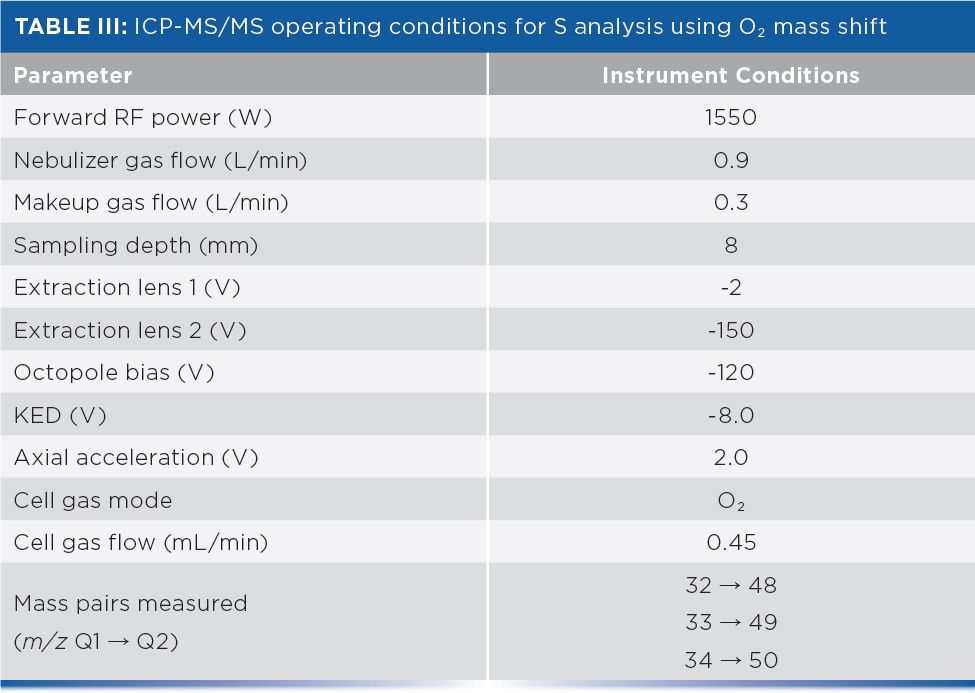
Sulfur standards and matrix element solutions were prepared from single element stock standards (Agilent Technologies). Sulfur isotope standards were prepared from sulfur isotope CRMs IAEA-S-1, S-2, and S-3 (National Institute of Standards and Technology [NIST]). Ultrapure water was prepared in the laboratory using a Milli-Q Element system, and acids used for sample stabilization and matrix preparation were Ultra pure Normatom grade (VWR Chemicals).
Results and Discussion
Comparing MS/MS and Single Quad Mode for Analysis of Sas SO+
The mass-shift approach to resolve interferences has been described extensively (17). To assess the ability of MS/MS to resolve matrix interferences on the sulfur isotopes, mass spectra were acquired covering the region where the S16O+ product ions would appear (m/z 48 for 32S16O+, m/z 49 for 33S16O+, and m/z 50 for 34S16O+). The same acquisition was performed in MS/MS mode and “single quad” mode, where Q1 is operated as a simple ion guide (no mass filtering). A 10 μg/L (ppb) S standard and separate solutions containing potentially interfering matrix elements Ca, Ti, and C were measured. The overlaid spectra (sulfur standard and matrix solutions) are shown for both modes in Figure 1.
Figure 1: Overlaid spectra of 10 μg/L (ppb) S standard (gray), 100 μg/L Ca matrix (blue), 100 μg/L Ti matrix (green), and 5% isopropyl alcohol (IPA, pink). (a) ICP-triple quadrupole MS in “single quad” mode (Q1 operated as an ion guide). (b) ICP-MS/MS (Q1 operated as 1 u mass filter). Existing element overlaps on the SO+ product ion masses are eliminated with MS/MS, enabling accurate sulfur isotope abundance template match (red outlines).
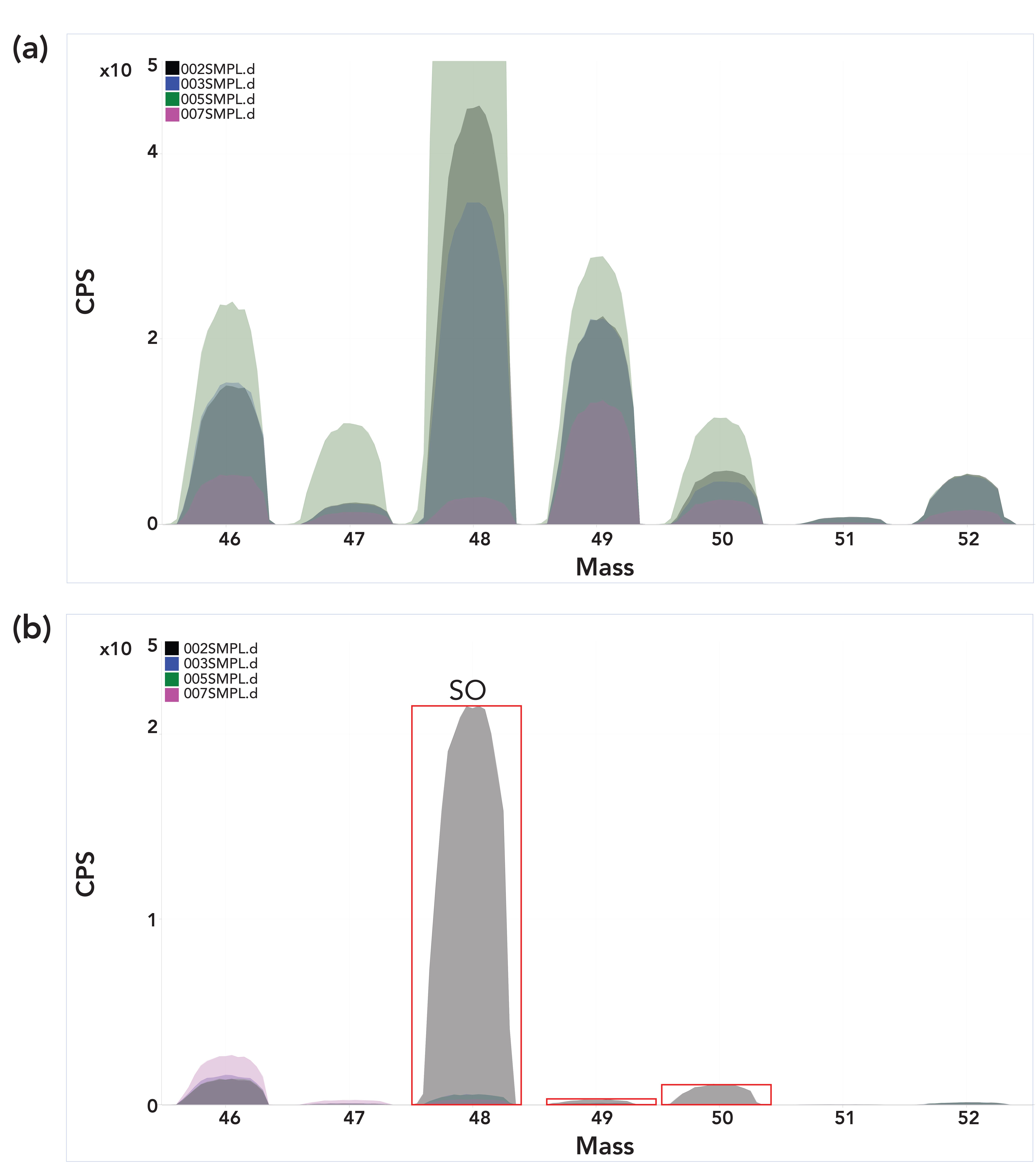
The good isotope template fit and freedom from matrix overlaps for sulfur in MS/MS mode contrasts markedly with the severe overlaps apparent in “single quad” mode. The difference is due to the inability of the single quadrupole to reject the existing Ca+, Ti+, and ArC+ ions at m/z 48 to 50, where the SO+ product ions are measured. In MS/MS, these interfering ions are all rejected by Q1, which is set to pass only the mass of the respective precursor S+ ions, so m/z 32 for 32S, m/z 33 for 33S, and m/z 34 for 34S.
Controlling Product Ion Formation with Q1 in MS/MS Mode
With O-atom addition reactions, the large (16 u) mass difference between the precursor and product ion masses means any existing ions at the product ion masses can be rejected, even if Q1 is operated in bandpass mode (mass window > 1 u). However, existing ion overlaps are not the only potential interferences that can affect the accurate measurement of S as SO+. If the sample contains phosphorus (P), 31P+ ions could also react with the O2 cell gas to form 31P17O+ product ions that would overlap the 32S16O+ product ions at m/z 48. This is illustrated in Figure 2, where a scan of a sulfur standard (25 μg/L) is shown overlaid with scans of 0.5% H3PO4 and 0.5% HCl. The solutions were measured in MS/MS mode and with Q1 set to pass a 3 u mass window (simulating bandpass operation). In bandpass mode, the P matrix gives rise to an intense interference at m/z 32, while MS/MS ensures effective resolution of the 31P17O+ product ions. Rejecting 31P+ while allowing transmission of 32S+ requires Q1 to operate as a 1 u mass filter (MS/MS mode).
Figure 2: Overlaid spectra of 25 μg/L (ppb) S standard (gray) and 0.5% H3PO4 matrix (pink); 0.5% HCl matrix (green) also shown. (a): ICP-triple quadrupole MS in “bandpass” mode (Q1 set to 3 u mass window). (b): ICP-MS/MS (Q1 operated as 1 u mass filter). PO+ product ion overlap on SO+ is eliminated with MS/MS, as confirmed by accurate S isotope abundance template match (red outlines).
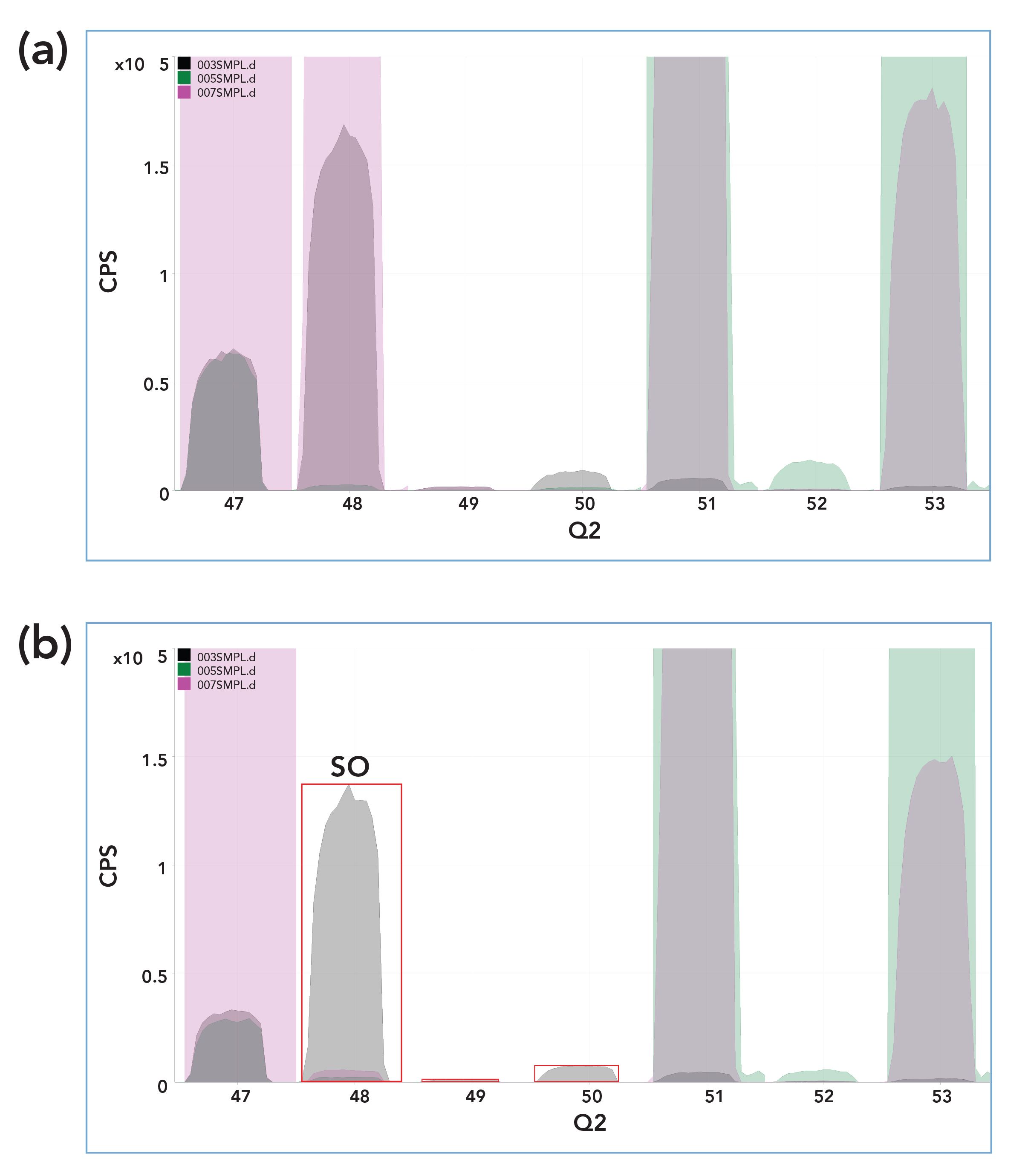
Sulfur Isotope Analysis in Natural Waters
The relative abundance of the stable (non-radiogenic) sulfur isotopes varies a lot in natural materials due to fractionation during redox reactions. The variation in abundances is calculated as a deviation (or delta, δ) in the abundance of the minor isotope (such as δ34S), expressed in per mil (parts per thousand, ‰). Natural materials such as groundwaters, soil, vegetation, and rocks can contain sulfur isotopes with δ34S values ranging from -40‰ to +40‰, and occasionally more (18). This variation enables researchers to study processes such as sedimentary rock formation and biogeochemical cycles. High precision sulfur isotope analysis is usually performed using an isotope ratio mass spectrometer (IRMS), such as a thermal ionization mass spectrometer (TIMS), secondary ionization mass spectrometer (SIMS), or multi-collector ICP-MS. However, the large variation in natural sulfur isotope abundances means that an ICP-MS/MS method with O2 cell gas can measure the differences in S ratios, albeit less precisely.
Determining accurate S isotope abundances by conventional ICP-MS can be affected by errors from interisotope overlaps. Where the mass that enters the CRC is not tightly controlled, multiple sulfur isotopes can react to form product ion overlaps. For example, 32S18O+ appears at the same mass as 34S16O+ (m/z 50), so accurate determination of 34S abundance is only possible if 32S+ is excluded from the CRC. As with adjacent mass overlaps (such as 31P17O+ on 32S16O+), resolving inter-isotope overlaps requires Q1 to operate as a 1 u mass filter (MS/MS).
Sulfur isotopes were measured in a range of mineral water, river water, spring water, and seawater samples, using ICP-MS/MS in mass-shift mode with O2 cell gas. Sulfur isotope calibration was based on IAEA-S-1, and bracketing standards were used for mass bias correction. The results are summarized in Figure 3. Excellent δ34S precision of less than 0.9‰ SD (n = 10) was obtained. The accuracy of the method was confirmed by the measured δ34S value for NASS 5 seawater (21.5‰), which agreed well with the global average value for oceanic seawater of 21‰ (18).
Figure 3: Sulfur isotope variation (δ34S, ‰) in water samples measured using ICP-MS/MS. Error bars show ±1 SD (n = 10). Precise S isotope ratios were obtained with SD less than 0.9‰, and clear differences in 34S isotope abundances could be seen. The measured δ34S value of 21.5‰ for NASS 5 seawater CRM agreed well with the global average δ34S value for oceanic seawater of 21‰ (18). Note: the symbol ‰ indicates parts per thousand (also called per mil) used to report isotope ratio precisions.
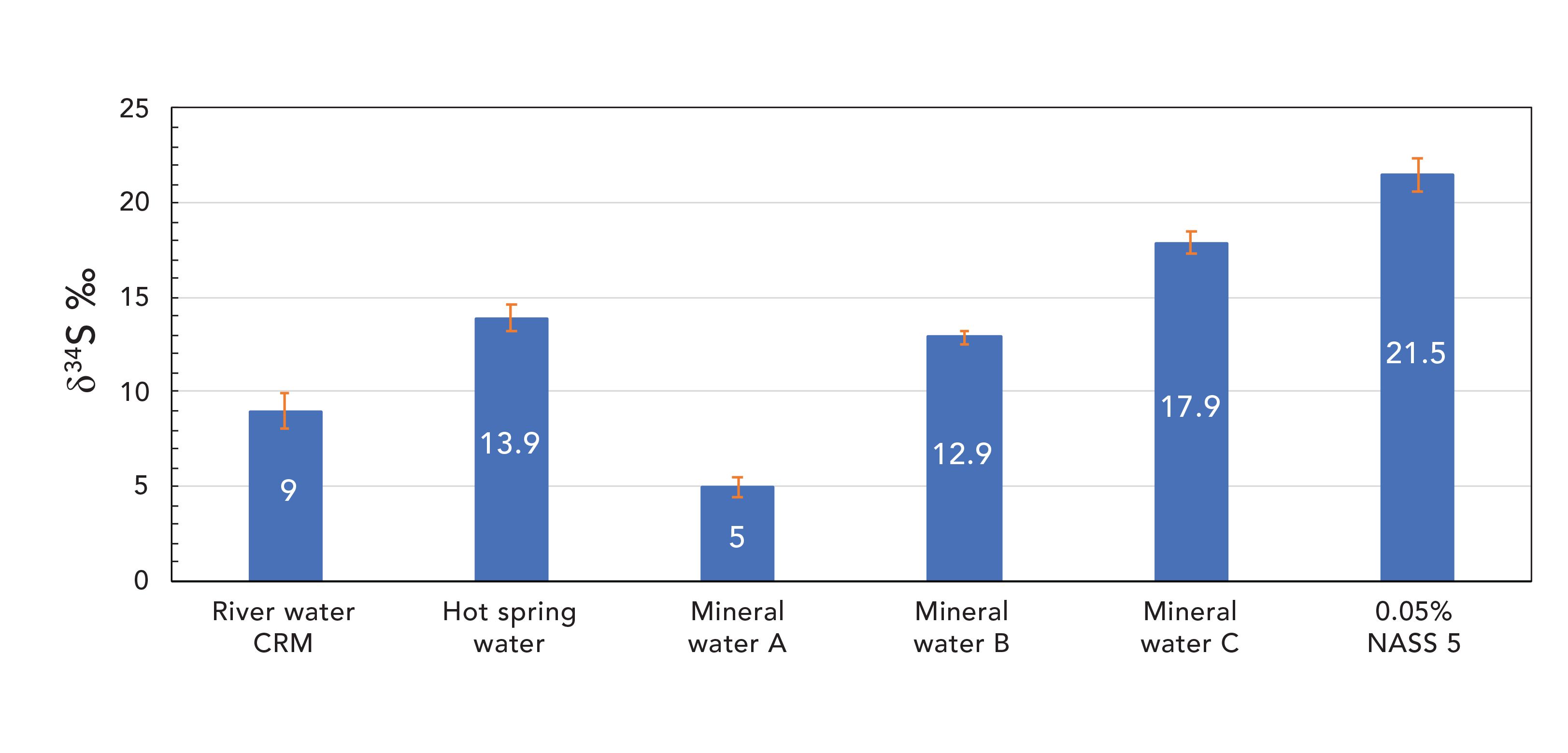
Sulfur isotope analysis in geochemistry applications may require the measurement of the 33S:32S ratio as well as 34S:32S. The 33S isotope can be measured as 33S16O+ using ICP-MS, but the large difference in abundance between 32S and 33S isotopes can cause errors in the analysis of the minor isotope. In ICP-MS/MS analysis using O2 mass shift, 32S must be excluded from the CRC when 33S is measured. This separation can be degraded either by poor Q1 resolution (mass window >1 u), or by poor abundance sensitivity (peak tail of 32S overlaps 33S). In both cases, the 32S peak would contribute to the signal at the adjacent mass 33, affecting the 33S:32S ratio.
This potential error was assessed by measuring digested sulfide minerals and calculating the mass-independent deviation in the measured abundance of the 33S isotope (δ33S). Mass independent fractionation of sulfur isotopes rarely occurs naturally, so the defect in 33S abundance calculated from ∆33S = δ33/32S - δ34/32S x 0.515 should equal zero, assuming equilibrium fractionation (19). A measured value of zero (within experimental error) therefore indicates no contribution from 32S on 33S. The results obtained with ICP-MS/MS are shown in Table IV, with a δ33S of -0.1 confirming no contribution from 32S on 33S measured as the 33S16O+ product ion.

Conclusions
ICP-MS/MS using O2 cell gas to mass shift the S+ ions to their respective SO+ product ion masses provides the opportunity to determine sulfur accurately at lower levels than was previously possible by ICP-MS. By allowing only the target S+ precursor ion into the CRC, MS/MS eliminates potential interferences from other reactive ions (such as 31P+) and from existing ions at the product ion masses (such as 48Ca+, 48Ti+, and 36Ar12C+).
MS/MS also excludes the possibility of inter-isotope overlaps, enabling accurate sulfur isotope analysis in complex sample matrices. These measurements cannot be performed successfully using conventional single quadrupole or bandpass ICP-MS.
References
- B. Bouyssiere, P. Leonhard, D. Profrock, F. Baco, C. L. Garcia, S. Wilbur, and A. Prange, J. Anal. At. Spectrom.19, 700–702 (2004).
- J. Heilmann, S.F. Boulyga, and K.G. Heumann, Anal. Bioanal. Chem. 380, 190–197 (2004).
- J.G. Martinez-Sierra, F.M. Sanz, P.H. Espilez, R. Santamaria-Fernandez, J.M.M. Gayon, and J.I.G. Alonso, J. Anal. At. Spectrom. 25, 989–997 (2010).
- C. Rappel and D. Schaumlöffel, Anal Bioanal Chem. 390, 605–615 (2008).
- B. Lajin, and W. Goessler, Anal. Chim. Acta 1092, 1–8 (2019).
- E.H. Evans, J.C. Wolff, and C. Eckers, Anal. Chem. 73, 4722–4728 (2001).
- C.J. Smith, I.D. Wilson, L. Weidolf, F. Abou-Shakra, and M. Thomsen, Chromatographia Suppl. 59, S165–S170 (2004).
- P.J. Turner, T. Merren, J. Speakman, and C. Haines, G. Holland, and S.D. Tanner (eds), Plasma Source Mass Spectrometry: Development and Applications. (The Royal Society of Chemistry, Cambridge, United Kingdom, 28–34,1997).
- N. Yamada, J. Takahashi, and K. Sakata, J. Anal. At. Spectrom.17, 1213–1222 (2002).
- E. McCurdy and G. Woods, J. Anal. At. Spectrom.19, 607–615 (2004).
- D. Pröfrock, P. Leonhard, and A. Prange, Anal. Bioanal. Chem. 377, 132–139 (2003).
- D.R. Bandura, V.I. Baranov, and S.D. Tanner, Anal. Chem. 74, 1497–1502 (2002).
- K. De Wolf, L. Balcaen, E. Van De Walle, F. Cuyckens, and F. Vanhaecke, J. Anal. At. Spectrom. 25, 419–425 (2010).
- S.D. Fernandez, N. Sugishama, J.R. Encinar, and A. Sanz-Medel. Anal. Chem. 84, 5851–5857 (2012).
- L. Balcaen, G. Woods, M. Resano, and F. Vanhaecke, J. Anal. At. Spectrom. 28, 33–39 (2013).
- K. Nakano, Ultra-low-level determination of phosphorus, sulfur, silicon and chlorine using the Agilent 8900 ICP-QQQ (Agilent application note 5991-6852EN, 2016).
- L. Balcaen, E. Bolea-Fernandez, M. Resano, and F. Vanhaecke, Anal. Chim. Acta 894, 7–19 (2015).
- T.B. Coplen, J.K. Böhlke, P. De Bièvre, T. Ding, N.E. Holden, J.A. Hopple, H. R. Krouse, A. Lamberty, H. S. Peiser, K. Revesz, S.E. Rieder, K.J.R. Rosman, E. Roth, P.D.P. Taylor, R.D. Vocke Jr., and Y.K. Xiao, Pure Appl. Chem. 74(10), 1987–2017 (2002).
- E.D. Young, A. Galy, and H. Nagahara, Geochim. Cosmochim. Acta 66(6), 1095–1104 (2002).
Ed McCurdy and Glenn Woods are withAgilent Technologies LDA (UK) Ltd, in the United Kingdom. Bastian Georg is with Agilent Technologies in Canada. Naoki Sugiyama is with Agilent Technologies International in Japan. Direct correspondence to: ed_mccurdy@agilent.com.
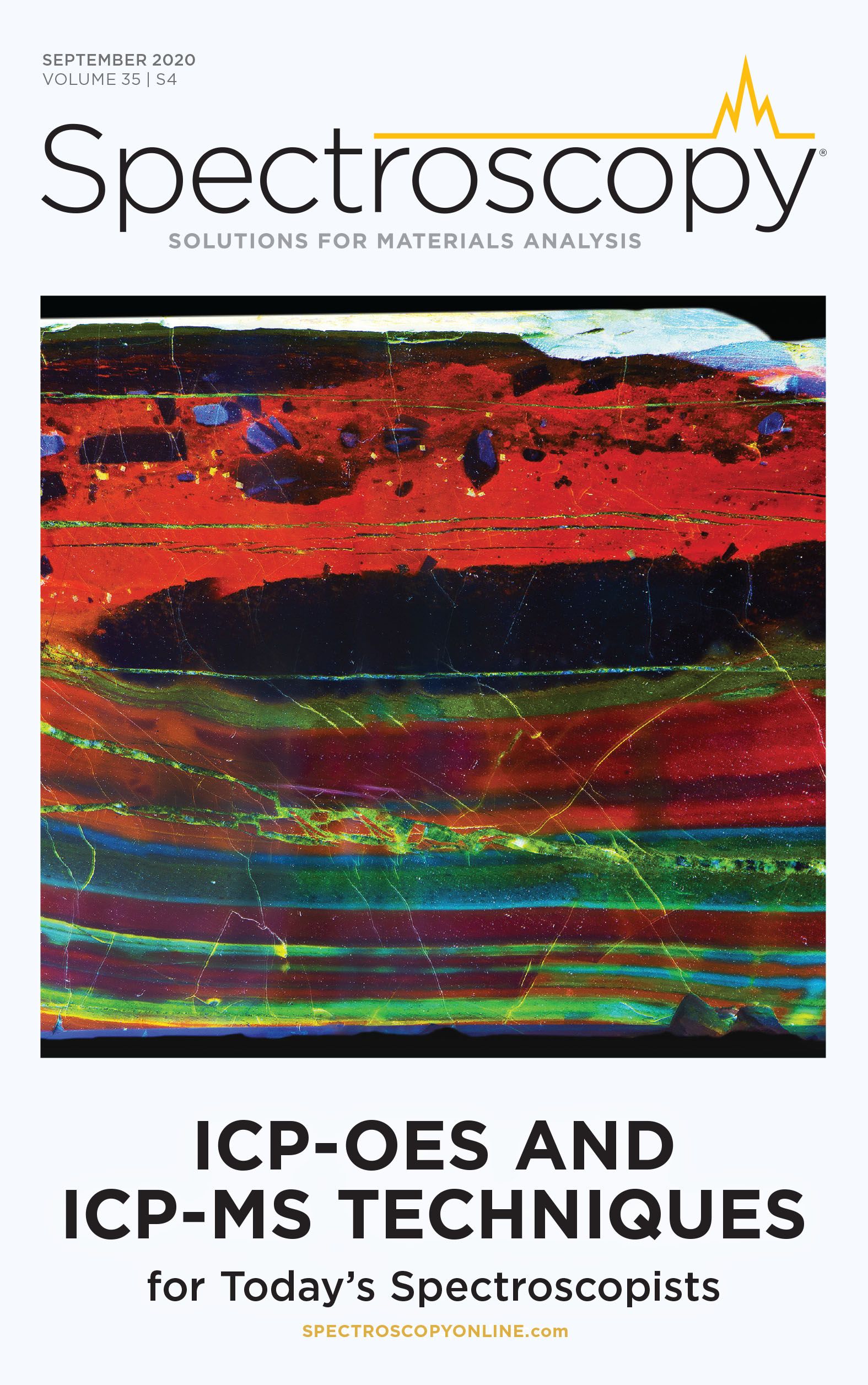
Trending on Spectroscopy: The Top Content of 2024
December 30th 2024In 2024, we launched multiple content series, covered major conferences, presented two awards, and continued our monthly Analytically Speaking episodes. Below, you'll find a selection of the most popular content from Spectroscopy over the past year.
Best of the Week: Hyperspectral Imaging, ICP-MS Analysis of Geological Samples, Product Roundup
October 18th 2024Top articles published this week include an article about hyperspectral imaging in human skin research, a peer-reviewed article about analyzing geological samples using atomic spectroscopy techniques, and an equipment roundup piece about the latest products in the industry.